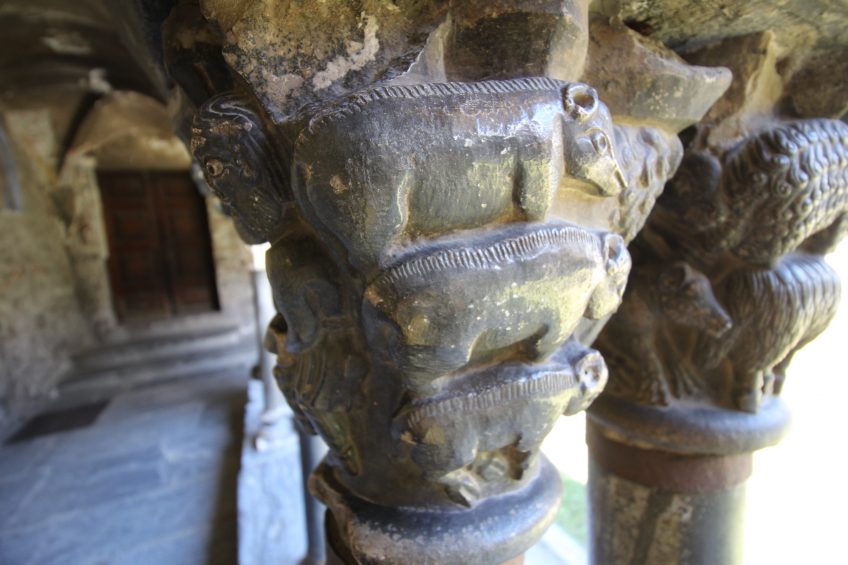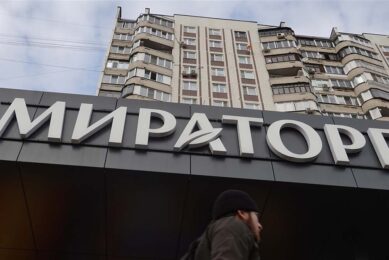Producing pigs – what was it like in the Middle Ages?

A depiction of pigs in a medieval church in northern Italy made Pig Progress editor Vincent ter Beek wonder what pig production must have been like in Italy in the early 12th century. It’s a story of oak forests, sheep, guilds and indigenous breeds.
If you didn’t know they were there, you may never have noticed them. The pigs on the picture below I photographed myself when being on holiday in Aosta, a city in the north of Italy, in a valley in the Alps.
The pigs formed the top decoration of columns in church cloisters, those of the St Orso collegiate church. These were constructed in 1133 AD, almost 900 years ago, I read. Taking a closer look, I noticed the animals seem to have hairs on their backs – are they wild boars? No, just look in the background – there’s a similar column, showing sheep.
I found pigs – even here in a place that breathes history!
Mirroring daily life
It is not as surprising as it might seem. Sculptures like these can be found in many medieval churches. Between religious works, usually craftsmen added elements from day-to-day life, sometimes even being slightly cheeky and furtively mocking ruling classes. Often, however, they just mirrored daily life.
Pig farming clearly was important enough in daily life to make it to a craftsman’s imagination. My mind drifted off. What kind of pig farming were we talking about in 12th century Italy?
Pig farming was profitable
Various sources report that the business had been very profitable, already in the Late Roman Empire, say from the years 0-400 AD. Just imagine the thriving city of classical Rome requiring tonnes of pork every year and it’s easy to imagine why providing pork to Rome alone would have been a very good business to be in.
Pigs, oaks and chestnuts
Interestingly, I found, pig production was an activity that was connected to oak forests, especially in the early Middle Ages. The pigs were usually kept in forests and usually fed on acorns. Prof Paolo Squatriti, Michigan University, USA, wrote in 2013 in his book Landscape and Change in Early Medieval Italy that the “size [of woodland] was evaluated in terms of the number of pigs a wood of oak could maintain.”
Prof Squatriti goes on to describe, however, as the centuries went by, chestnut forests became more preferred by Italy’s inhabitants, as chestnuts were versatile trees and unlike acorns, chestnuts were commonly also eaten by humans. As pigs eat anything, pigs and chestnut groves therefore did not go well together. When chestnuts – castagna – became a staple diet, goats and sheep gained in importance, as they showed to have no interest in the chestnuts.
Pigs were liked
The growing importance of the chestnut trees is not likely to have caused a dip in pig production. In personal correspondence, Prof Squatriti e-mailed me, “the bones of pigs are found quite abundantly in early medieval garbage dumps.” Likely, the forests led to ‘spatial zoning’, pigs were restricted to mature forests but kept away from the ‘nut-producing groves’. After all, pigs were useful, he writes in his book, “Pigs were the most efficient transformers available in the Mediterranean of materials people could not eat into something people liked.”
And people did like pork! When Italy’s medieval cities gradually started to flourish after the year 1000 – guilds of pig slaughterers and processors sprang up everywhere. The city of Bologna for instance, knew powerful groups of skilled workers specialised in preserving pork meat. In the late 13th century, almost 300 of these shops had formed.
Pig breed?
A quick word on the breed of pigs they might have used: Italy used to know a wide variety of indigenous breeds, of which most have disappeared. In total, 6 have been saved from extinction only a few years ago and have been given official protective status by the Italian ministry of agriculture and forestry. These are the Apulo-Calabrese, the Casertana, the Cinta Senese, the Mora Romagnola, the Nero Siciliano and the Sarda. All continue to exist now, mostly in fairly small populations.
And yes, some of these breeds have been known for a long time. The picture below shows a fragment of a mural painting, which can be found in Siena’s town hall – it shows a pig farmer, most probably having a Cinta Senese breed with him. The painting is dated back to 1339.

So where was pig production at in Northern Italy in 1133, at the time when the stone pigs were carved on top of the column? I conclude it must have been a fairly profitable business – in oak forests or with special care around chestnut forests. I imagine the early pig herdsmen to be using local breeds – and there were definitely people in the cities who knew how to deal with pig carcasses.
Aosta Valley in 2016
Nowadays, there are no pigs any more in the Aosta Valley. Pigs haven’t been counted there since the mid-1990s. As motorways have made the area very accessible, it’s probably easier to transport pork there than to try and raise pigs against alpine slopes.
Dairy cows, that’s about it, according to Eurostat.
 Beheer
Beheer








 WP Admin
WP Admin  Bewerk bericht
Bewerk bericht